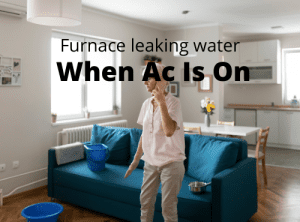Comfort Aire Inc offers the best services of heating repairs of your furnace leaking water when ac is on. For more information, you can call (773) 406-7223.
Water pooling inside your home is never a good sign, but a leaky furnace, while the AC is running is cause for alarm. Pooling water or excessive condensation can create mold, mildew, allergies, and corrosion damage! Excess moisture might cause your HVAC system to fail sooner than expected, so address as quickly as feasible.
What causes the leak? Before calling in the pros, read this article to learn about the possible reasons for AC furnace water leakage. The fact that your AC unit’s drain pipe is the same as your furnace’s drain pipe causes the leak to be visible. When the AC unit fails, the furnace leaks.

What To Do If Your AC Leaks Water While Running
But first, turn off your HVAC. Turn off your HVAC system if you discover your furnace leaking water while the AC is running. If the off switch is blocked or difficult to find, you can turn it off at the fuse box. If you have access to a Wet Vac (a water-sucking vacuum), use it to remove standing water. The presence of standing water can harm flooring or trigger an electrical fire if it contacts an outlet.
Why Is My Furnace Leaking Water?
Drain Line Not Flushing: The most straightforward remedy is that your drain pipe gets knocked free. Verify that it aligns with your unit’s output. If it’s loose, realign it and tighten the seal.
On those hot and humid NYC days, your AC unit will produce some condensation. However, if the drain pipe becomes clogged, the water can back up and eventually leak! If the problem is a blocked drain, there are several ways to clear it. To clean it, use a wet vac to suck away any material in the pipe. You can also use compressed air to remove the obstruction. Finally, you may buy drain cleaning tablets at most grocery or hardware stores. You can also contact 24-hour furnace repair.
Like air conditioning ducts, the evaporator coil draws in air and cools and dehumidifies it through a series of coils. As the air is dehumidified, condensation forms which can be drained into a pan. If your evaporator coil isn’t working correctly, it might lead to excessive water production and cause your AC furnace to leak water.
Cracked Drain Pan: When the evaporator coil works appropriately, the condensation drips into a pan that drains the pipe. If this pan is damaged, water will drip down the inside of your unit, causing your furnace to leak water when the AC is on!
Water Leak From Furnace Ac Is On
Clogged Condensation Drainpipe/trap
A clogged condensation drain pipe or condensation trap might cause water leakage from your furnace. High-efficiency furnaces operate more excellent, causing condensation. Leaks are modest at first but can be severe. Ignoring leaks can cost you. Regularly maintaining a high-efficiency furnace can prevent more significant issues. Both the internal and outdoor coils of air conditioners produce condensation that must be removed. Condensation leaks and clogged traps can cause home damage and equipment issues. So don’t disregard them. Many people don’t know their furnace is leaking water when ac is on.
The condensate from the exhaust is usually piped to a floor drain. If a floor drain is not closed, a condensate pump can be fitted to divert the water. Debris, algae, and sediments can build up in the condensation trap, blocking adequate drainage. This can cause an apparent leak when the water is driven out.
Condensation Pump Check
Check your condensate pump if your HVAC system uses one. Pour water in it to do this. Like a sump pump, the condensate pump should activate when the water level reaches a specified level. If you add enough water, but the condensate pump doesn’t work, you may have located the source of the leak.
Misplaced Drain Pipe
A faulty PVC drain pipe system is another major cause of furnace water leakage. If the drain line is not fitted at an appropriate downward angle, the condensate line may not drain effectively.
Nose Clog
Your AC has two coils. A coil indoors and out. Water leaking from the furnace is prevalent when the air conditioner runs via the interior coil. A condensate drain line clog in your indoor AC coil often causes water seeping from the furnace while the AC is running.
Water pouring into your furnace components might cause significant issues. The bottom of the furnace and other parts can rust and stop operating, causing an electrical short and reducing the furnace’s life.
Furnace Leaking Water When Ac Is Off
When your air conditioner cools your home, it also eliminates humidity by converting it to water, collected in a pan called the condensate drain pan. Water exits your home via the condensate drain line from the drain pan. This pipe may become clogged with dirt, debris, rust, and algae accumulation. A clogged condensate drain line might result in more severe difficulties, including the following:
- Water damage ranging from hundreds to thousands of dollars
- A breeding place for pathogens such as mold, mildew, viruses, and bacteria
- Fires in homes, In some instances, leaked water may drip onto electrical components, resulting in a fire.
- If you have water dripping from the ceiling and your furnace or air handler is located in the attic, the most likely reason is a clogged condensate drain line.
Furnace Leaking Water When Heat Is On
This is a less common occurrence, although it does occur. The following are the most frequently cited reasons.
Leakage from the Condensate Drain
If your furnace’s efficiency is greater than 90%, it is referred to be a condensing furnace. This phrase alludes to moisture, which must be drained. Water is a byproduct of natural gas and propane burning. Indeed, two water molecules are created for every molecule of carbon dioxide produced. That is a significant amount of water generated by a condensing furnace. If you’re unsure whether your furnace is condensing, locate the vent that exhausts air from your home. Is it PVC – white polyvinyl chloride? That is a condensation vent from a condensing furnace. If the material is metal, you have a non-condensing furnace without a condensate pump.
The Condensate Pump Is Inoperable
Typically, high-efficiency condensing furnaces drain down. On the other hand, a pump is required if the water must be pumped up and out of a basement or crawlspace. We mentioned this previously, as the pump operates during air conditioning cycles. Refer to number 2 under Furnace Leaks When Air Conditioning Is On.
Leakage from the Humidifier
If you have a humidifier, this is almost certainly the most likely cause of the problem. There are various possible reasons for a humidifier to leak while operating. The majority of remedies, or at the very least diagnostics, are do-it-yourself.The water supply line is dangling or broken. Cut off the water supply. If the leak is no longer there, tighten the fittings, apply Teflon tape, or inspect for a crack. If the line is cracked, it is most likely that the fitting was overtightened. Due to mineral build-up, the pad is unable to absorb water. Replace it if it is hard and crusty.
Drainage is obstructed. Certain humidifiers get excessive water or, like steam humidifiers, must be flushed regularly. In either scenario, the humidifier comes equipped with a drain. Remove the drain fitting and loosen the clog with a wire or small screwdriver.
Your Heat Exchanger has Developed a Crack
Your furnace’s heat exchanger is its heart. It conducts heat from the combustion chamber to the ducting that distributes air around your home. Water, as previously stated, is a byproduct of combustion. Usually, moisture is expelled from the furnace and your home via the vent (and the condensate drain in a high-efficiency furnace).
If the heat exchanger is damaged, the moisture inside the furnace may escape. Is your carbon monoxide monitor indicating a problem? This is another indication that the heat exchanger is damaged — and leaked hazardous gases. If this is the case, switch off the heat and contact a furnace repair provider. Do-It-Yourself Solution? Certainly not this one. To access the heat exchanger, the furnace must be removed considerably. The majority of professionals do not even attempt this. Rather than that, they advocate furnace replacement.
Why? Because a cracked heat exchanger typically occurs later in the life of a furnace — after ten years or more. While heat exchanger guarantees are 20 years or a lifetime, the warranty does not cover labor to replace the part. What a pleasant surprise! Labor costs for replacing a heat exchanger range between $800 and $1,500, depending on the furnace and the repair business. That money, in our opinion, would be better spent on a new furnace. If this is the case and you wish to avoid the repair vs replace problem in the future, consider a Goodman furnace. A lifetime warranty covers the heat exchanger on the top-of-the-line Goodman furnaces. If the heat exchanger fails, Goodman will replace the furnace.
